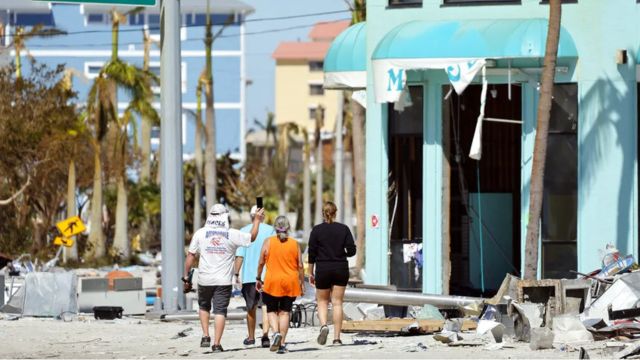The insurance expenses were the last straw for Filicia Porter. As Florida was pummeled by increasingly intense storms, they had been steadily increasing her assisted-living business until suddenly the numbers stopped adding up.
She ultimately made the decision to retire in March and closed the clinic she had founded just two years prior, close to Palm Beach. That occurred four months after she shut down a previous Port St. Lucie branch that had opened in 2017. Altogether, they caused twelve inhabitants to hastily look for alternative accommodations.
“You notice an increase every year. Why spend extra money? Porter, who founded The House of Cares in the first place to take advantage of the growing need for elder care as baby boomers moved into the Sunshine State, stated. She was unable to “continue to deplete” herself, though, as her premiums increased in addition to all of her other expenses.
Porter is just one tiny example out of many in Florida where the burden of caring for an aging population and the effects of climate change are converging. Baby boomers have been pouring money into the retirement haven for years, attracted by the cheap taxes and pleasant weather, making the state home to one of the oldest populations in the nation. The effects of rising temperatures are having unanticipated ripple effects on the economy, making it a warning sign for neighboring states.
According to credit rating agency AM Best Co. Inc., rates for commercial property insurance increased last year at a rate that was over five times higher than the national average due to the danger of stronger hurricanes for Florida. This is imposing what caregivers claim is essentially a new tax on their business, one that is already dealing with labor shortages, skyrocketing wages, and growing supplier costs. However, the levy has received little attention.
What was the outcome? Every year, an increasing number of nursing homes close their doors, and some fail to make their debt payments. Simultaneously, the expenses associated with elder care, ranging from independent living to 24-hour nursing, are increasing, endangering the financial stability of an increasing proportion of retirees.
The founder and CEO of Innovation Senior Living, a Winter Park-based company with 339 residents in its facilities that provide assisted living and memory care, Pilar Carvajal, declared, “We are headed into a train wreck.” Over the last five years, its insurance prices have increased by at least 50%. “To solve this societal problem, we need assistance,” she declared.
Few localities have been hurt worse than Florida by the nationwide increase in commercial property insurance premiums brought on by climate change. The five-year period ending in 2023 saw a 125% increase in costs. According to AM Best, annual premiums increased by over 27% in the state last year, marking the second consecutive year of increases, while the national growth rate decreased to roughly 6% from roughly 15%.
Senior vice president Patrick McConachie of the Marsh McLennan Agency in Tampa, who assists senior-living operators in negotiating policies, stated, “We have many clients that can’t afford the coverage.” “Recently, the operator in many cases in Florida will just hand the keys back to the landlord.”
According to President and CEO Rob Greene, Palm Garden Healthcare closed its assisted-living facility earlier this year due to rapidly rising costs. In just two years, the property insurance cost for his chain of fourteen nursing homes more than doubled to $2.2 million. Greene further said that even though he is paying more for insurance, the coverage for damages up to $75 million is significantly less than the minimum $200 million he requires.
Since it first opened for business in the late 1980s, Palm Garden has not yet suffered significant storm damage; but, “come June, we get a little bit nervous,” according to Greene.
“Sensing The Crunch”
As per the National Centers for Environmental Information, the damage caused by natural disasters such as tropical cyclones and strong storms increased by up to $200 billion between 2019 and 2023 compared to the previous decade. Hurricane Ian, the third-most expensive hurricane in US history, is included in that five-year total.
A few property insurers folded due to the growing number of claims, which raised prices. However, the Insurance Information Institute’s head of corporate communications, Mark Friedlander, says that seven new companies are anticipated to join the market this year. Additionally, Jack Walker, senior sales executive at AssuredPartners, an Orlando-based insurer that specializes in senior housing, indicated that talks with reinsurers went well and that this year’s premium increases might be flat or slightly smaller.
But until then, business owners like Innovation and Palm Garden must figure out how to cover the skyrocketing expenses. The elderly residents of Palm Garden are eligible for Medicaid, but Greene claims that the payments are never sufficient. He remarked, “We don’t have the luxury of being able to pass on costs, like, a McDonald’s.”
Even they will eventually become “unaffordable” for operators serving wealthier retirees who have the ability to raise and pass the price on, according to Margaret Johnson, senior director at Fitch Ratings.
According to Raoul Nowitz, senior managing director of SOLIC Capital Advisors, an expert in investment banking and restructuring for troubled businesses, “residents are feeling the pinch.” He also said that operators are having trouble making enough cash flow to pay off debt.
Although the increase in insurance prices affects every Florida community, from homeowners to hotels, it is especially detrimental to this sector of the economy. Johnson of Fitch has a poor credit outlook for the industry.
Richard Scanlon, senior managing director at B.C. Ziegler and Company, stated that labor and property-insurance costs are “at the top of the list of things that keep them up at night” when he interacts with chief financial officers of Florida senior-living communities.
According to Municipal Market Analytics, 21 out of 34 first-time payment defaults on debt issued for Florida retirement homes since 2009 occurred after the outbreak. Based on data provided by Bloomberg, the default rate for senior living in Florida is 18%, which is more than twice the national rate of approximately 8%.
Read more: As debt becomes due, there will be more defaults for senior living.
The relationship between supply and demand
Numerous facilities have been closing as a result of this strain. Data from the Florida Agency for Health Care Administration shows that over the five years ending in 2023, an average of 146 assisted-living or nursing homes closed annually. The year 2022 had the greatest number of closures during that time, as Hurricane Ian made landfall and federal pandemic help was coming to an end.
The continuous closures happen when the need increases and the likelihood of additional facilities dwindles. According to the US Census Bureau, Florida is the state with the second-fastest rate of population growth in the US, after Texas. It also has the second-highest percentage of older residents among US states, with over 22% of its population over 65, compared to just 17% nationwide.
The growing population requires new facilities to open more quickly, according to Lisa Washburn, chief credit officer at Municipal Market Analytics, who also noted that “construction has slowed significantly” in the US. According to her, government intervention is necessary in order to finance or assist construction.
Insurance is a tax, even if Florida does not have an income tax, according to Washburn.
In order to maintain insurance after Hurricane Ian, Carvajal was required to put a $200,000 new roof on one of her six sites.
“How can one manage when things like property insurance are getting so complicated and unpredictably bad?” she said. “I don’t know what we’re going to do if things continue to get worse in the future.”

